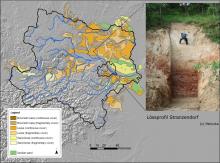Project Loess Paleosol Map of Lower Austria
Lower Austrian soils on loess substrates have a high silt content and, although prone to erosion, are particularly well suited for viticulture.
Significant archaeological finds are repeatedly made in loess deposits, and they also reveal important climatological or environmental-historical information.
Picture: The LPS Stranzendorf with a mighty "tropical" paleosol.
Paleosols, on the other hand, originated from soil-forming processes during the warm periods and contain immanently important information about site and environmental conditions for science.
Some of the world's most significant loess paleosol sequences (LPS) are found in Lower Austria. Quaternary geological information is permanently stored in these profiles, allowing statements to be made about the historical landscape development of Lower Austria - and more broadly for Central Europe.
A large number of inquiries from domestic and foreign researchers concerning these "hard drives of nature" confirm the interest and international importance of these Lower Austrian type localities. In many cases these are the profiles of Willendorf, Stranzendorf (see picture), Krems and Stillfried.
All these sites have in common that they are repeatedly in the center of recent scientific publications on international, national and local level.
In this project of the Lower Austrian government the distribution of the different solution types of Lower Austria and their included paleosols will be presented in a digital map. The data will be stored in a geoinformation system and will be adapted for different uses and can be supplemented continuously.
Ass.-Prof. Mag. Dr. Robert Peticzka
Althanstraße 14 (UZA II)
1090 Wien
Room: 2A391
T: +43-1-4277-48670
M: +43-664-60277-48670
robert.peticzka@univie.ac.at
Universitätsstraße 7 (NIG)
1010 Wien
Department of Geography and Regional Research
https://geographie.univie.ac.at/en/
https://geographie.univie.ac.at/en/working-groups/geoecology/
04.11.2025
EUSDR PA10: 12th Danube Participation Day in Sarajevo
more ...30.10.2025
Online-Präsentation BBK-Projekt CNSoil - Zwischenergebnisse
more ...07.10.2025
CatchHedge - Potenziale von Hecken im Zeichen des Klimawandels
more ...16.+17.09.2025
32nd Conference of the Danube Region
more ...12.09.2025
Grundlagen der professionellen Bio-Mandel-Produktion
more ...10.09.2025
Agroforst u. Marktgärtnerei, Symbiose
more ...05.09.2025
Regionales Wiesensaatgut gewinnen mit dem Wiesensamenernter
more ...25.06.2025
Feldtag - StripTill im Bio-Mais im Trockengebiet
more ...25.06.2025
Seminar: Wildbienen- und Nützlingsförderung im Biolandbau
more ...24.06.2025
BOKU Green Plate Forum 3.0
more ...24.06.2025
Die Maulbeere - Kultur, Produktion u.Verwendung
more ...17.06.2025
Frühjahrstagung Österr. Gesellschaft für Agrar- und Umweltrecht (ÖGAUR)
more ...13.06.2025
Seminar: Artenvielfalt in Ackerbauregionen fördern
more ...03.06.2025
Seminar: Keine Angst vor der Ackerdistel
more ...03.06.2025
Agroforstsysteme: Anbau-Modelle der Zukunft
more ...20.05.2025
IDM-Generalversammlung 2025
more ...15.05.2025
Seminar: Unkräuter/Beikräuter erkennen und als Zeigerpflanzen nutzen
more ...13.+14.05.2025
Bodenforum Österreich - Frühjahrstreffen
more ...04.05.2025
Tageskurs: Perma-Veggies - Mehrjähriges Gemüse und essbare Stauden
more ...03.05.2025
Waldgärten-Exkursion
more ...



